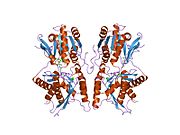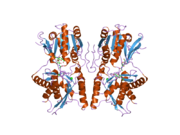Protein-coding gene in humans
| NPR3 |
|---|
|
| Available structures |
|---|
| PDB | Ortholog search: PDBe RCSB |
|---|
| List of PDB id codes |
|---|
1JDN, 1JDP, 1YK0, 1YK1 |
|
|
| Identifiers |
|---|
| Aliases | NPR3, ANP-C, ANPR-C, ANPRC, C5orf23, GUCY2B, NPR-C, NPRC, natriuretic peptide receptor 3, BOMOS |
|---|
| External IDs | OMIM: 108962; MGI: 97373; HomoloGene: 699; GeneCards: NPR3; OMA:NPR3 - orthologs |
|---|
| Gene location (Human) |
|---|
 | | Chr. | Chromosome 5 (human)[1] |
|---|
| | Band | 5p13.3 | Start | 32,689,070 bp[1] |
|---|
| End | 32,791,724 bp[1] |
|---|
|
| Gene location (Mouse) |
|---|
 | | Chr. | Chromosome 15 (mouse)[2] |
|---|
| | Band | 15 A1|15 5.83 cM | Start | 11,839,982 bp[2] |
|---|
| End | 11,907,373 bp[2] |
|---|
|
| RNA expression pattern |
|---|
| Bgee | | Human | Mouse (ortholog) |
|---|
| Top expressed in | - glomerulus
- metanephric glomerulus
- kidney tubule
- cardiac muscle tissue of right atrium
- stromal cell of endometrium
- renal medulla
- human kidney
- myocardium of left ventricle
- visceral pleura
- lower lobe of lung
|
| | Top expressed in | - atrioventricular valve
- white adipose tissue
- atrium
- left lung lobe
- right lung lobe
- Epithelium of choroid plexus
- choroidal fissure
- ankle
- brown adipose tissue
- lactiferous gland
|
| | More reference expression data |
|
|---|
| BioGPS | |
|---|
|
| Gene ontology |
|---|
| Molecular function | - hormone binding
- natriuretic peptide receptor activity
- G protein-coupled peptide receptor activity
- protein binding
- chloride ion binding
- peptide binding
- protein homodimerization activity
- peptide hormone binding
| | Cellular component | - integral component of membrane
- membrane
- integral component of plasma membrane
- intracellular anatomical structure
- extracellular exosome
- protein-containing complex
| | Biological process | - skeletal system development
- negative regulation of smooth muscle cell proliferation
- positive regulation of urine volume
- pancreatic juice secretion
- regulation of osteoblast proliferation
- regulation of blood pressure
- phospholipase C-activating G protein-coupled receptor signaling pathway
- positive regulation of nitric-oxide synthase activity
- phosphatidylinositol-mediated signaling
- osteoclast proliferation
- negative regulation of adenylate cyclase activity
- adenylate cyclase-inhibiting G protein-coupled receptor signaling pathway
- negative regulation of cold-induced thermogenesis
| | Sources:Amigo / QuickGO |
|
| Orthologs |
|---|
| Species | Human | Mouse |
|---|
| Entrez | | |
|---|
| Ensembl | | |
|---|
| UniProt | | |
|---|
| RefSeq (mRNA) | NM_000908
NM_001204375
NM_001204376
NM_024563
NM_001363652
|
|---|
NM_001364458
NM_001364460 |
| |
|---|
NM_001039181
NM_001286395
NM_008728 |
|
|---|
| RefSeq (protein) | NP_000899
NP_001191304
NP_001191305
NP_001350581
NP_001351387
|
|---|
NP_001351389 |
| |
|---|
NP_001034270
NP_001273324
NP_032754 |
|
|---|
| Location (UCSC) | Chr 5: 32.69 – 32.79 Mb | Chr 15: 11.84 – 11.91 Mb |
|---|
| PubMed search | [3] | [4] |
|---|
|
| Wikidata |
| View/Edit Human | View/Edit Mouse |
|
Natriuretic peptide receptor C/guanylate cyclase C (atrionatriuretic peptide receptor C), also known as NPR3, is an atrial natriuretic peptide receptor. In humans it is encoded by the NPR3 gene.[5]
Function
The family of natriuretic peptides elicit a number of vascular, renal, and endocrine effects that are important in the maintenance of blood pressure and extracellular fluid volume. These effects are mediated by specific binding of the peptides to cell surface receptors in the vasculature, kidney, adrenal, and brain.[5]
See also
References
- ^ a b c GRCh38: Ensembl release 89: ENSG00000113389 – Ensembl, May 2017
- ^ a b c GRCm38: Ensembl release 89: ENSMUSG00000022206 – Ensembl, May 2017
- ^ "Human PubMed Reference:". National Center for Biotechnology Information, U.S. National Library of Medicine.
- ^ "Mouse PubMed Reference:". National Center for Biotechnology Information, U.S. National Library of Medicine.
- ^ a b "Entrez Gene: NPR3 natriuretic peptide receptor C/guanylate cyclase C (atrionatriuretic peptide receptor C)".
Further reading
- Fox AA, Collard CD, Shernan SK, et al. (2009). "Natriuretic peptide system gene variants are associated with ventricular dysfunction after coronary artery bypass grafting". Anesthesiology. 110 (4): 738–47. doi:10.1097/ALN.0b013e31819c7496. PMC 2735337. PMID 19326473.
- Moffatt P, Thomas G, Sellin K, et al. (2007). "Osteocrin is a specific ligand of the natriuretic Peptide clearance receptor that modulates bone growth" (PDF). J. Biol. Chem. 282 (50): 36454–62. doi:10.1074/jbc.M708596200. PMID 17951249. S2CID 7185411.
- Pitzalis MV, Sarzani R, Dessì-Fulgheri P, et al. (2003). "Allelic variants of natriuretic peptide receptor genes are associated with family history of hypertension and cardiovascular phenotype". J. Hypertens. 21 (8): 1491–6. doi:10.1097/00004872-200308000-00012. hdl:11566/50999. PMID 12872042. S2CID 40988095.
- Fan D, Bryan PM, Antos LK, et al. (2005). "Down-regulation does not mediate natriuretic peptide-dependent desensitization of natriuretic peptide receptor (NPR)-A or NPR-B: guanylyl cyclase-linked natriuretic peptide receptors do not internalize". Mol. Pharmacol. 67 (1): 174–83. doi:10.1124/mol.104.002436. PMID 15459247. S2CID 53520.
- He XL, Chow DC, Martick MM, Garcia KC (2001). "Allosteric activation of a spring-loaded natriuretic peptide receptor dimer by hormone". Science. 293 (5535): 1657–62. Bibcode:2001Sci...293.1657H. doi:10.1126/science.1062246. PMID 11533490. S2CID 6030635.
- Soranzo N, Rivadeneira F, Chinappen-Horsley U, et al. (2009). Visscher PM (ed.). "Meta-analysis of genome-wide scans for human adult stature identifies novel Loci and associations with measures of skeletal frame size". PLOS Genet. 5 (4): e1000445. doi:10.1371/journal.pgen.1000445. PMC 2661236. PMID 19343178.
- Olsen JV, Blagoev B, Gnad F, et al. (2006). "Global, in vivo, and site-specific phosphorylation dynamics in signaling networks". Cell. 127 (3): 635–48. doi:10.1016/j.cell.2006.09.026. PMID 17081983. S2CID 7827573.
- He XL, Dukkipati A, Garcia KC (2006). "Structural determinants of natriuretic peptide receptor specificity and degeneracy". J. Mol. Biol. 361 (4): 698–714. doi:10.1016/j.jmb.2006.06.060. PMID 16870210.
- Rubattu S, Stanzione R, Di Angelantonio E, et al. (2004). "Atrial natriuretic peptide gene polymorphisms and risk of ischemic stroke in humans". Stroke. 35 (4): 814–8. doi:10.1161/01.STR.0000119381.52589.AB. PMID 15017020.
- Iemitsu M, Maeda S, Otsuki T, et al. (2008). "Arterial stiffness, physical activity, and atrial natriuretic Peptide gene polymorphism in older subjects". Hypertens. Res. 31 (4): 767–74. doi:10.1291/hypres.31.767. PMID 18633189.
- Dickey DM, Yoder AR, Potter LR (2009). "A familial mutation renders atrial natriuretic Peptide resistant to proteolytic degradation". J. Biol. Chem. 284 (29): 19196–202. doi:10.1074/jbc.M109.010777. PMC 2740543. PMID 19458086.
- Gratacòs M, Costas J, de Cid R, et al. (2009). "Identification of new putative susceptibility genes for several psychiatric disorders by association analysis of regulatory and non-synonymous SNPs of 306 genes involved in neurotransmission and neurodevelopment". Am. J. Med. Genet. B Neuropsychiatr. Genet. 150B (6): 808–16. doi:10.1002/ajmg.b.30902. PMID 19086053. S2CID 44524739.
- Aoi N, Soma M, Nakayama T, et al. (2004). "Variable number of tandem repeat of the 5'-flanking region of type-C human natriuretic peptide receptor gene influences blood pressure levels in obesity-associated hypertension". Hypertens. Res. 27 (10): 711–6. doi:10.1291/hypres.27.711. PMID 15785005.
- Anand-Srivastava MB (2005). "Natriuretic peptide receptor-C signaling and regulation". Peptides. 26 (6): 1044–59. doi:10.1016/j.peptides.2004.09.023. PMID 15911072. S2CID 6734231.
- Estrada K, Krawczak M, Schreiber S, et al. (2009). "A genome-wide association study of northwestern Europeans involves the C-type natriuretic peptide signaling pathway in the etiology of human height variation". Hum. Mol. Genet. 18 (18): 3516–24. doi:10.1093/hmg/ddp296. PMC 2729669. PMID 19570815.
- Burgess MD, Moore KD, Carter GM, et al. (2009). "C-type natriuretic peptide receptor expression in pancreatic alpha cells". Histochem. Cell Biol. 132 (1): 95–103. doi:10.1007/s00418-009-0591-3. PMID 19352691. S2CID 9116972.
- Vassalle C, Andreassi MG, Prontera C, et al. (2007). "Influence of ScaI and natriuretic peptide (NP) clearance receptor polymorphisms of the NP System on NP concentration in chronic heart failure". Clin. Chem. 53 (11): 1886–90. doi:10.1373/clinchem.2007.088302. PMID 17890443.
- Lee JK, Kim HT, Cho SM, et al. (2003). "Characterization of 458 single nucleotide polymorphisms of disease candidate genes in the Korean population". J. Hum. Genet. 48 (5): 213–6. doi:10.1007/s10038-003-0011-9. PMID 12768436.
- van den Akker F (2001). "Structural insights into the ligand binding domains of membrane bound guanylyl cyclases and natriuretic peptide receptors". J. Mol. Biol. 311 (5): 923–37. doi:10.1006/jmbi.2001.4922. PMID 11556325.
- He XL, Dukkipati A, Wang X, Garcia KC (2005). "A new paradigm for hormone recognition and allosteric receptor activation revealed from structural studies of NPR-C". Peptides. 26 (6): 1035–43. doi:10.1016/j.peptides.2004.08.035. PMID 15911071. S2CID 28281513.
External links
This article incorporates text from the United States National Library of Medicine, which is in the public domain.
PDB gallery
-
1yk0: structure of natriuretic peptide receptor-C complexed with atrial natriuretic peptide -
1jdp: Crystal Structure of Hormone/Receptor Complex -
1yk1: structure of natriuretic peptide receptor-C complexed with brain natriuretic peptide -
1jdn: Crystal Structure of Hormone Receptor |
 | This membrane protein–related article is a stub. You can help Wikipedia by expanding it. |
 1yk0: structure of natriuretic peptide receptor-C complexed with atrial natriuretic peptide
1yk0: structure of natriuretic peptide receptor-C complexed with atrial natriuretic peptide 1jdp: Crystal Structure of Hormone/Receptor Complex
1jdp: Crystal Structure of Hormone/Receptor Complex 1yk1: structure of natriuretic peptide receptor-C complexed with brain natriuretic peptide
1yk1: structure of natriuretic peptide receptor-C complexed with brain natriuretic peptide 1jdn: Crystal Structure of Hormone Receptor
1jdn: Crystal Structure of Hormone Receptor


















